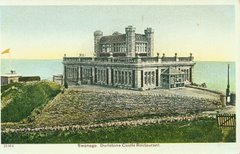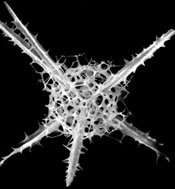 April 27th 2007
April 27th 2007Reading the books Sam gave me I have been getting to grips with some actual information about microfossils and how the different species of coccolithopore (for example) changed in response to environmental pressure. I realise that they change shape over their lifetimes and that there are ways of analysing their basic shapes. Their response to climate change is less observable as single mutations within a single species - rather that the population densities will shift over time and that this community is called the 'assemblage'.
Perhaps I should look at assemblage changes rather than changes within a population. I can't help looking for material clues. There are three classifications of foraminifera. 'Agglutinated', 'Porcellaneous' and 'Hyaline'. Hyaline means glassy, porcellaneous needs no elucidation, and agglutinated sounds like glued together which is no accident. These relate to the different way that the critters are structured.
Fluctuations in salinity, temperature, oxygen, food, and light all seem to affect the assemblage of these critters.
I look at graphs showing extinction patterns and biodiversity explosions. I look at line-charts that show how rocks can be aged by searching for particularly short-lived fossils which will give an accurate dating. I read about the K/T boundary which was the moment when all the dinosaurs as well as almost everything else were wiped out by a meteorite. I also look at geological maps of the coast and the bandings and patternings of the rocks, colour-coded for easy distinction. I love the functional beauty and accuracy of maps.
I also find that humanity has been affecting biodiversity for far longer than I had thought. Ingenious fossil studies show that the wooly mammoth was eliminated though over-hunting by human communities, not climate change... and that's at a time when hardly any humans existed.
Separately to this rather cerebral research I hold a 'clay' day at the Ruskin School of Fine Art in Oxford where I teach BA students. A potter from Dorset leads the day. At one point I am given a handful of clay and find myself amazed by it's plasticity. Clay is incredibly malleable. I thoughtlessly poke holes in it with my fingers as I watch the others until it's just a mass of holes. Looking at what I have accidentally 'made' I realise that this is the shape of a plankton I had seen in Sam Gibb's slide presentation in March. As a process leading to a form it's simple and fast. Jonathan makes his own clay from the soil in his garden. Could we make clay on the Durlston site and work with it?


No comments:
Post a Comment